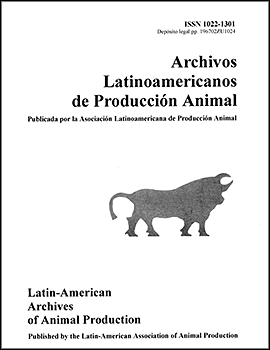
|
Archivos Latinoamericanos de Produccion Animal
Asociacion Latinoamericana de Produccion Animal
ISSN: 1022-1301
EISSN: 1022-1301
Vol. 14, No. 3, 2006, pp. 84-85
|
 Bioline Code: la06014
Bioline Code: la06014
Full paper language: Spanish
Document type: Research Article
Document available free of charge
|
|
|
Archivos Latinoamericanos de Produccion Animal, Vol. 14, No. 3, 2006, pp. 84-85
| es |
Producción de biomasa de la lenteja de agua ( Lemna minor  ), fertilizada con estiércol de ovinos ), fertilizada con estiércol de ovinos
A. Espejo-Dêaz, R. Sánchez, R. González, A. Silva, A. Vargas, P. Merchán y G. Nouel
Resumen
En enero de 2003, en la Unidad de Investigación en Producción Animal, Lara, Venezuela, la lenteja de agua ( Lemna minor

) fue cultivada en microlagunas para determinar su producción de biomasa. Se realizaron tres experimentos (E) con diseños completamente aleatorizados, a saber: E1 (T0= 30 g de lenteja de agua, T1= 30 g de lenteja de agua y 32 g de fertilizante); E2 (T0= 5 g de lenteja de agua, T1= 5 g de lenteja de agua y 32 g de fertilizante), con 25 repeticiones por tratamiento; y E3 (T0= 5 g de lenteja de agua, T1= 5 g de lenteja de agua y 20 g de fertilizante, T2= 5 g de lenteja de agua y 30 g de fertilizante, y T3= 5 g de lenteja de agua y 40 g de fertilizante), con 15 repeticiones por tratamiento. La Lemna minor presentó una mayor producción de biomasa al ser fertilizada, y el rendimiento fue dependiente de las cantidades de material vegetativo y fertilizante que se adicionaron en la microlaguna.
Lenteja de agua, Lemna minor, producción de biomasa, cantidad de semilla, fertilización orgánica.
|
| |
| en |
Biomass production of duckweed ( Lemna minor  ) fertilized with ovine manure ) fertilized with ovine manure
A. Espejo-Dêaz, R. Sánchez, R. González, A. Silva, A. Vargas, P. Merchán y G. Nouel
Abstract
In January 2003, in the Animal Production Research Unit, Lara, Venezuela, duckweed ( Lemna minor

) was cultured in microlagoons to determine biomasa production. Three experiments (E) were carried out with a totally randomized design: E1 (T0 = 30 g of duckweed, T1 = 30 g of duckweed and 32 g of fertilizer), E2 (T0 = 5 g of duckweed, T1 = 5 g of duckweed and 32 g of fertilizer), with 25 repetitions per treatments; and E3 (T0 = 5 g of duckweed, T1 = 5 g of duckweed and 20 g of fertilizer, T2 = 5 g of duckweed and 30 g of fertilizer, and T3 = 5 g of duckweed and 40 g of fertilizer), with 15 repetitions per treatment. The duckweed gave higher yieldeds when fertilized, and the yields depended of the quantities of vegetative material and fertilizer added to the microlagoon.
Duckweed, Lemna minor, biomass production, seed quantity, organic fertilization.
|
| |
© Copyright 2006 - ALPA. Arch. Latinoam. Prod. Anim.
Alternative site location: http://www.alpa.org.ve/ojs/index.php
|
|
